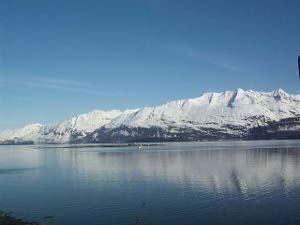We're still early for most of the tourist attractions. Mainly this is an  Valdez Harbor
advantage. Driving the small number of Alaskan roads we find little traffic. We're not bothered by closed fishing camps because we're not planning to fish or camp. We're seeing wildlife through unleafed trees, possibly closer to the road than they'll be later in the season when visitors increase. The snow-covered mountains and ice-banked rivers offer dramatic views. The mosquitos haven't hatched, and most motels will offer a reduced rate for another week or so!
Valdez Harbor
advantage. Driving the small number of Alaskan roads we find little traffic. We're not bothered by closed fishing camps because we're not planning to fish or camp. We're seeing wildlife through unleafed trees, possibly closer to the road than they'll be later in the season when visitors increase. The snow-covered mountains and ice-banked rivers offer dramatic views. The mosquitos haven't hatched, and most motels will offer a reduced rate for another week or so!
Disadvantages, mostly minor, are missing a few museums and historic buildings, and having a smaller number of cafes and motels to pick from. Throughout Alaska many miles separate towns and settlements and off-season we drive somewhat farther between stops. We won't be seeing the summer wildflowers, or the mountains covered with green instead of white.
Still, we would recommend driving this country, preferably at this time  Snowy mountain landscape
of year, to really see it. And we find our Milepost guide a terrific companion because of its thoroughness and ease of use. It has alerted us to many little interesting tidbits we'd otherwise just sail on past.
Snowy mountain landscape
of year, to really see it. And we find our Milepost guide a terrific companion because of its thoroughness and ease of use. It has alerted us to many little interesting tidbits we'd otherwise just sail on past.
Before leaving Valdez we visited the pipeline terminal; it can handle two supertankers (250,000 DWT) and two ordinary tankers at a time; there's space for a fifth berth. They scour the tankers' ballast water, reclaim the oil and discharge the "clean" water at sea.
We drove from Valdez to Anchorage, returning north through beautiful Thompson Pass, then following the Chugash Mountains to the west until we came to the city. We loved the melting rivers, sparkling waterfalls and views of snow-capped mountains and glaciers.
 Matanuska River
Matanuska River
At first the changes were barely perceptible -- one more isolated cabin, a few more cars on the road, a little settlement -- but the closer we got to Anchorage the greater the evidences of civilization. There were lots of fishing camps and "wilderness resorts," people working outside, then fields of hay and cows! We read in the guide book that during the Depression, one of FDR's alphabet soup agencies had picked up a few hundred bankrupt farmers from the north central states and shipped them up to the territory of Alaska to plant crops. The result is that the town of Palmer is now the location of the annual Alaska State Fair! People drive up from Anchorage in summer to buy fresh vegetables.
We followed the Matanuska River to its mouth, passed an Army convoy, and then were on a four-lane divided highway -- the only one in Alaska -- for the last 40 miles to Anchorage. As we crossed the wetlands near the river mouth we spied a moose grazing behind some trees. The reason is clear: Anchorage is warmer than Valdez, and spring comes earlier, so there were fresh leaves on the trees for moose to chomp. When it got over 50 we rolled down the windows, found the afternoon traffic jam and our hotel.
 Valdez Harbor
advantage. Driving the small number of Alaskan roads we find little traffic. We're not bothered by closed fishing camps because we're not planning to fish or camp. We're seeing wildlife through unleafed trees, possibly closer to the road than they'll be later in the season when visitors increase. The snow-covered mountains and ice-banked rivers offer dramatic views. The mosquitos haven't hatched, and most motels will offer a reduced rate for another week or so!
Valdez Harbor
advantage. Driving the small number of Alaskan roads we find little traffic. We're not bothered by closed fishing camps because we're not planning to fish or camp. We're seeing wildlife through unleafed trees, possibly closer to the road than they'll be later in the season when visitors increase. The snow-covered mountains and ice-banked rivers offer dramatic views. The mosquitos haven't hatched, and most motels will offer a reduced rate for another week or so!
 Snowy mountain landscape
Snowy mountain landscape Matanuska River
Matanuska River